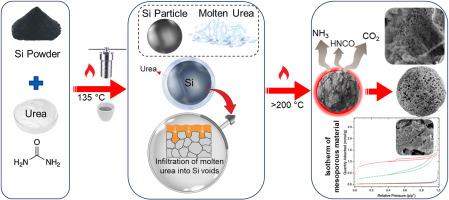Safe and cost-effective synthesis of porous silicon using Urea: Structural, morphological, and porosity analysis
IF 4.7
3区 材料科学
Q1 CHEMISTRY, APPLIED
引用次数: 0
Abstract
Porous silicon (Si) has gained significant interest in various applications due to its high surface area, tunable pore structure, excellent chemical reactivity, biocompatibility, and surface functionalization potential. Traditional methods for synthesizing porous Si often rely on hydrofluoric acid, a hazardous chemical that poses significant environmental and safety risks, limiting its scalability and sustainability. In this study, a green and scalable approach for synthesizing porous Si microparticles through urea-assisted etching is presented and evaluated as a function of temperature and container conditions (crucible vs. autoclave). The urea etching transformed pristine silicon microparticles, with a non-porous structure and a BET surface area of 2.3 m2/g, into porous silicon with surface areas as high as 26.7 m2/g. The highest porosity was achieved at 400 °C, while higher temperatures (600 °C and 800 °C) led to diminished porosity and surface restructuring. Quantitative analysis revealed a maximum etching yield of 17.5 %, etching rate of 14.6 mg/h, and a pore formation efficiency of ∼43 %. The crystalline structure of silicon remained intact across all treatments, with minor surface disorder observed at higher temperatures. The urea-assisted etching produced a temperature-and environment-dependent surface oxidation and nitrogen incorporation. At 220 °C and 400 °C, a thick oxide layer formed, particularly under high-pressure conditions, while oxidation was less pronounced at 600 °C and 800 °C, likely due to rapid thermal decomposition limiting sustained gas-solid interactions. Nitrogen incorporation was most significant in Si-220-HP, where multiple nitrogen environments were detected, including Si–N, NH2/NH3+, and NOx species. At higher temperatures, only stable Si–N bonds persisted, while other nitrogen species diminished.

利用尿素安全、经济地合成多孔硅:结构、形态和孔隙度分析
多孔硅(Si)由于其高表面积、可调节的孔结构、优异的化学反应性、生物相容性和表面功能化潜力而在各种应用中获得了极大的兴趣。传统的多孔硅合成方法通常依赖于氢氟酸,这是一种危险的化学品,具有重大的环境和安全风险,限制了其可扩展性和可持续性。在本研究中,提出了一种绿色且可扩展的方法,通过尿素辅助蚀刻合成多孔硅微粒,并评估了温度和容器条件(坩埚与高压釜)的函数。尿素蚀刻将原始的无孔结构、BET比表面积为2.3 m2/g的硅微粒转化为比表面积高达26.7 m2/g的多孔硅。在400°C时孔隙度最高,而更高的温度(600°C和800°C)导致孔隙度降低和表面重构。定量分析显示,最大蚀刻率为17.5%,蚀刻速率为14.6 mg/h,孔隙形成效率为~ 43%。硅的晶体结构在所有处理中都保持完整,在高温下观察到轻微的表面紊乱。尿素辅助蚀刻产生了温度和环境相关的表面氧化和氮掺入。在220°C和400°C时,形成了一层厚厚的氧化层,特别是在高压条件下,而在600°C和800°C时氧化不太明显,可能是由于快速热分解限制了持续的气固相互作用。在Si-220-HP中,氮的掺入最为显著,其中检测到多种氮环境,包括Si-N, NH2/NH3+和NOx物种。在较高的温度下,只有稳定的Si-N键持续存在,而其他氮元素则减少。
本文章由计算机程序翻译,如有差异,请以英文原文为准。
求助全文
约1分钟内获得全文
求助全文
来源期刊

Microporous and Mesoporous Materials
化学-材料科学:综合
CiteScore
10.70
自引率
5.80%
发文量
649
审稿时长
26 days
期刊介绍:
Microporous and Mesoporous Materials covers novel and significant aspects of porous solids classified as either microporous (pore size up to 2 nm) or mesoporous (pore size 2 to 50 nm). The porosity should have a specific impact on the material properties or application. Typical examples are zeolites and zeolite-like materials, pillared materials, clathrasils and clathrates, carbon molecular sieves, ordered mesoporous materials, organic/inorganic porous hybrid materials, or porous metal oxides. Both natural and synthetic porous materials are within the scope of the journal.
Topics which are particularly of interest include:
All aspects of natural microporous and mesoporous solids
The synthesis of crystalline or amorphous porous materials
The physico-chemical characterization of microporous and mesoporous solids, especially spectroscopic and microscopic
The modification of microporous and mesoporous solids, for example by ion exchange or solid-state reactions
All topics related to diffusion of mobile species in the pores of microporous and mesoporous materials
Adsorption (and other separation techniques) using microporous or mesoporous adsorbents
Catalysis by microporous and mesoporous materials
Host/guest interactions
Theoretical chemistry and modelling of host/guest interactions
All topics related to the application of microporous and mesoporous materials in industrial catalysis, separation technology, environmental protection, electrochemistry, membranes, sensors, optical devices, etc.
 求助内容:
求助内容: 应助结果提醒方式:
应助结果提醒方式:


